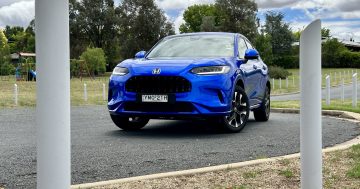Would you pay $7 to put an “M1 Inside” holographic sticker on your Mac? Andrew Cunningham* might.
 A confession: I like the little processor stickers that come on computers.
A confession: I like the little processor stickers that come on computers.
Not the huge billboard-y ones that yell about a few laptop features and invariably leave a huge, sticky-residue rectangle on the palm rest when you try to peel them off.
I’m not that weird.
But I like the little sometimes-holographic ones about the CPU (and sometimes the GPU) inside your PC.
If you share my affliction, I recently discovered designs by Vinoth Ragunathan that recreate those holographic stickers for the M1 and M2-series processors in Apple Silicon Macs.
Available for $7 a pop (or $16 for three), the stickers for each processor come with a different holographic colour palette.
It might horrify those of you who peel these little advertisements off of your PCs as soon as you get them, but we sticker lovers aren’t alone.
Ragunathan has sold hundreds of these Apple Silicon stickers—over 450 for the M1 Pro version alone—and there’s a thriving aftermarket on eBay for case stickers for new and old CPUs from Intel and AMD, versions of Windows, GeForce and Radeon GPUs, and lots of other components besides.
Some people, it turns out, like being able to see what’s inside a computer from the outside.
In defense of the CPU sticker
Why do I like these little labels when most people either ignore them or peel them off? They were initially conceived as a mutually beneficial advertisement for Intel and the PC makers, boosting Intel’s brand recognition and partially subsidizing marketing costs for companies that opted in.
(These subsidies were the subject of more than one legal fight for Intel over the years.)
Some of it is functional.
I worked in IT for several years, when I would be called on to troubleshoot multiple generations of similar-looking business PCs in a single day, and the CPU stickers could be an early, at-a-glance representation of how old the system was and what it was capable of.
They serve the same function on the PCs of friends and family for whom I still provide unpaid-but-usually-appreciated IT services.
But it’s also just a hint of nostalgia for the PC market of 25 years ago when processor speeds were changing and improving more rapidly.
For those of us who had to get by with hand-me-downs, used parts, and bargain-basement beige boxes, the little CPU case badge could indicate that we were using something newer instead of something older.
Was the Celeron sticker on the front of a cheap eMachines box objectively exciting? Not to most people.
But if the computer it replaced was an old hand-me-down 486 that could barely handle connecting to AOL, it was a symbol of modernity.
The stickers could also be about bragging rights or expressions of self (in the weird, not-super-healthy way that people can view the things they buy as an extension of the things they value).
I did my first ground-up PC build in the summer of 2005 during the height of the Pentium 4-vs-Athlon 64 wars, and putting that little Athlon sticker on the outside of my cheap, acrylic-windowed PC case felt like a way to express my technical know-how and signal my support of AMD’s David against Intel’s Goliath.
I’m past that sort of fandom now, but I still like the little stickers.
I have a couple of PC cases that have been with me through multiple processor upgrades, and I like to carefully peel off the old stickers and put them somewhere inconspicuous inside the case.
The one on the outside represents what the computer is currently; the ones on the inside are a record of where the PC has been, like the stamps inside an old passport.
All of this might feel totally foreign to longtime Mac users who have never really owned or cared about the world of Windows PCs.
PowerPC Mac models in the mid-’90s post-Steve Jobs, pre-Jobs interregnum shipped with “PowerPC” stamped on their cases, but that (mostly) stopped with Jony Ive-era designs like the iMac.
Steve Jobs pointedly didn’t want Intel’s stickers anywhere near Apple’s Macs, and a sticker-free guarantee was said to be part of Apple’s contract with Intel when Apple switched from PowerPC chips to Intel’s in 2006.
(Publicly and diplomatically, he called the stickers “redundant” since “everyone knows we’re using Intel processors.”)
And that’s fine.
I’m not against pristine, sticker-less computers.
But for the sticker-loving weirdos like me, the holographic Apple Silicon stickers are a fun throwback and a way to add just a touch of old-school PC to our speedy, efficient Macs.
*Andrew Cunningham is a Senior Technology Reporter at Ars Technica with over a decade of experience in consumer tech, covering everything from PCs to Macs to smartphones to game consoles.
This article first appeared at arstechnica.com





